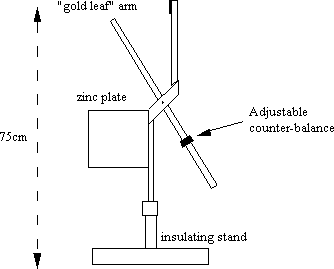What it shows:
A direct observation that the photoelectric effect is color (i.e. frequency) dependent and not intensity dependent. We discharge an electroscope using UV radiation after all attempts to discharge it with light of a longer wavelength has failed.
How it works:
An ebonite rod and fur is used to place a negative charge onto a Braun electroscope (figure 1) fitted with a thick zinc plate. Deviation of the electroscope arm from the vertical indicates a net negative charge. Next we hit it with light from a 1000W filament lamp whose radiation is primarily towards the red end of the spectrum; it has no effect on the electroscope despite its intensity. When we approach the electroscope with a less intense UV source, the electroscope discharges.
figure 1. Braun Electroscope
Setting it up:
Prepare the Braun electroscope by making sure the zinc is clean; give it a quick polish with steel wool. The arm needs to be correctly balanced so that it rests vertically but will swing about 30° when charged. Connect the bulb through a variac. The UV source is a small dental style Pen-ray UV source (UV Products, San Gabriel, CA). The zinc plate purchased after great searching from a naval/shipping supply, has to have one face very smooth and clean. The charge is provided by an ebonite rod and fur—use a heat lamp to make sure this is dry.
Comments:
The 1000W bulb is BRIGHT and the UV source tiny—a graphic illustration that the photoelectric effect is intensity independent. Show also that the electroscope won’t discharge when a positive charge (supplied by a glass rod and silk) is placed on it.
References:
1. Physics Demonstration Experiments ed. H. F. Meiners (AAPT 1970) vol.II p.836